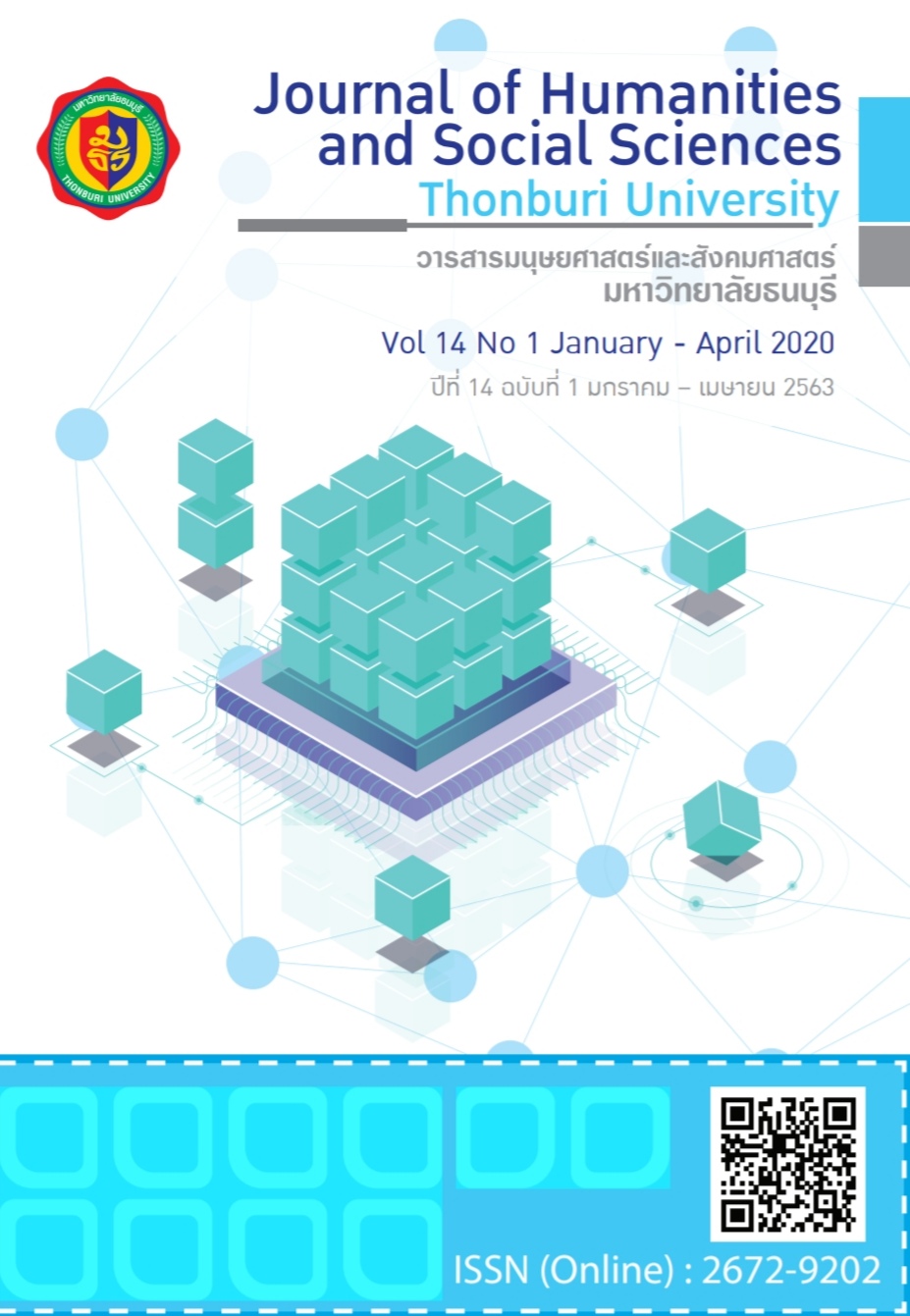The push and pull factors towards Japanese elderly tourists to travel in Thailand
Keywords:
The Push and Pull Factors, Tourist’s Behavior, Japanese elderly touristsAbstract
This is a quantitative research. It aims to study 1) The Push and Pull Factors of Japanese elderly tourists concern tourist’s behavior and 2) Perspective of Thailand tourism’s Image that affecting to travel in Thailand. The data was collected using questionnaires for the sample group is 370 Japanese elderly tourists who were traveling in Thailand by convenience sampling technique.
The results had shown that mainly male Japanese elderly tourists. The age between 55-64 years old, with mainly education level at bachelor’s degree, most are employee having annual income 300,000-400,000 Yen (85,000-120,000 Bath) per month. The behavior of Japanese elderly tourists mainly been visited Thailand than once, and searching for information from social multimedia such as the internet. The purpose of their travels was a travel/recreation and they liked to travel visit cultural attractions by coming with their family. They had lay over duration for 5-7 days and average expenses for travel was 150,000 Yen onward (4,200 baht onward) and mainly Wellness’s tourists who answered the questionnaires wanted to travel to Thailand again. Furthermore, most tourists regarded that perspective of Thailand tourism’s Image from Japanese elderly tourists mainly aspect of Thai’s culture & tradition were impressed. Followed by image of quality and diversity of tourism; value and tourism experience; ease of access attractions and safety in traveling, respectively.
References
กรมการท่องเที่ยว. (2554). แผนพัฒนาการท่องเที่ยวแห่งชาติ พ.ศ.2555-2559. กรุงเทพฯ: กระทรวงการท่องเที่ยวและกีฬา
กระทรวงการท่องเที่ยวและกีฬา. (2558). ยุทธศาสตร์การท่องเที่ยวไทย พ.ศ. 2558-2560. กรุงเทพฯ: กระทรวงการ ท่องเที่ยวและกีฬา.
กองเศรษฐกิจการท่องเที่ยวและกีฬาแห่งประเทศไทย. (2560). สถิตินักท่องเที่ยวจำแนกตามลักษณะรวมหน่วย. กรุงเทพฯ: ฝ่ายศูนย์บริการข้อมูลท่องเที่ยว.
จีรพร ศรีวัฒนานุกูลกิจ; และ เศกสิน ศรีวัฒนานุกูลกิจ. (2557) ความต้องการและความพึงพอใจของชาวต่างชาติในการพำนักระยะยาว ในจังหวัดเชียงใหม่. เชียงใหม่: มหาวิทยาลัยเชียงใหม่.
เฉลิมพล แจ่มจันทร์. (2555). มโนทัศน์ใหม่ของ “นิยามผู้สูงอายุ” และ “อายุเกษียณ” ทำไมต้อง 60 ปี เปลี่ยนได้หรือไม่. นครปฐม: มหาวิทยาลัยมหิดล.
ดวงดาว โยชิดะ; ชวลีย์ ณ ถลาง; สุทธินันทน์ พรหมสุวรรณ; และ สหนนท์ ตั้งเบญจสิริกุล. (2561, ตุลาคม). ความคาดหวังและความพึงพอใจในการเดินทางท่องเที่ยวประเทศไทยของนักท่องเที่ยวผู้สูงอายุชาวญี่ปุ่น. วารสารวิชาการมหาวิทยาลัยธนบุรี. 12(ฉบับพิเศษ): 127-137.
ธนวัต คองประเสริฐ; สมชนก ภาสกรจรัส; และ พันธุมดี เกตะวันดี. (2557). ปัจจัยที่มีอิทธิพลต่อประเภทนักท่องเที่ยวญี่ปุ่นในจังหวัดเชียงใหม่. วารสารวิทยาลัยการจัดการ. 31(2): 1-33.
ธีร์ ตีระจินดา. (2555). การส่งเสริมการท่องเที่ยวผู้สูงอายุชาวญี่ปุ่นในตลาดท่องเที่ยวประเทศไทย. วิทยาศาสตร์มหาบัณฑิต จุฬาลงกรณ์มหาวิทยาลัย.
ราณี อิสิชัยกุล. (2557). การจัดการการท่องเที่ยวเฉพาะทาง. กรุงเทพฯ: มหาวิทยาลัยสุโขทัยธรรมาธิราช.
เศรษฐกิจ. (2561). ททท.ดึงคนญี่ปุ่นเที่ยวเมืองรอง. สืบค้นเมื่อ 9 กุมภาพันธ์ 2561, จาก https://www.posttoday.com/economy/539770
สถานเอกอัครราชทูตญี่ปุ่นประจำประเทศไทย. (2559). จำนวนชาวญี่ปุ่นที่พักอาศัยในประเทศไทย. สืบค้นเมื่อ 3 สิงหาคม 2553, จาก http://www.th.embjapan.go.jp/jp/consular/zairyuto.htm.
สำนักงานปลัดกระทรวงการท่องเที่ยวและกีฬา. (2559). รายงานภาวะเศรษฐกิจท่องเที่ยวฉบับที่ 6. กรุงเทพฯ: เอ็กเซลเลนท์ บิสเนส แมเนจเม้นท์.
อนันต์ อนันตกูล. (2560). สังคมสูงวัย ความท้าทายประเทศไทย. สำนักธรรมศาสตร์และการเมือง: ราชบัณฑิตยสภา.
อุษณีย์ ผาสุข. (2557). การศึกษาภาพลักษณ์การท่องเที่ยวของประเทศไทยในมุมมองของนักท่องเที่ยวชาวญี่ปุ่น. วิทยานิพนธ์ศิลปศาสตร มหาบัณฑิต. พะเยา: มหาวิทยาลัยพะเยา.
เอ็มจีอาร์. (2560). ญี่ปุ่นรับมืออย่างไรกับสังคมคนแก่. สืบค้นเมื่อ 18 กันยายน 2560, จาก https://mgronline.com/ japan/detail/9600000095683
Cochran, W. G. (1977). Sampling Techniques. 3rded. New York: John Wiley & Sons.
Greenberg, G. M. (1999). Understanding the Older Consumer: the Grey Market. Choice. 36: 1662-1663.
Shoemaker, S. (2000). Segmentation the Market: 10 Years Later. Journal of Travel Research. 39(1): 11-26.
Wuest, B., Emenheiser, D., and Tas, R. (2001). Is the Lodging Industry Serving the Needs of Mature Consumers: A Comparison of Mature Travelers and Lodging Managers Perceptions of Service Needs. Journal of Hospitality & Leisure Marketing. 8(3/4): 85-96.
Translated Thai References
Anantakul, A. (2017). Aging society Challenges Thailand. Thammasat and Political Bureau: Royal Thai Academy. (in Thai)
Chaemchan, C. (2012). New concept of "Definition of the elderly" and "retirement age". Why must 60 years be changed? Nakhon Pathom: Mahidol University. (in Thai)
Chumyen, K. (2012). Self-tourism behavior of Japanese elderly tourists in Thailand Case study of Japanese tourists in Chiang Mai province. Chiang Mai: Chiang Mai University. (in Thai)
Department of Tourism. (2011). National Tourism Development Plan 2012-2016. Bangkok: Ministry of Tourism and sports. (in Thai)
Economic Tourism and Sports Division. (2017). Tourist statistics classified by unit aggregation characteristics. Bangkok: Tourist Information Center. (in Thai)
Economy. (2018). TAT draws Japanese people to travel to secondary cities. Retrieve 9 February 2018, from https://www. posttoday.com/economy/539770 (in Thai)
Embassy of Japan in Thailand. (2016). Number of Japanese residents in Thailand. Retrieve on 3 August 2010 from http:// www.th.embjapan.go.jp/jp/consular/zairyuto.htm (in Thai)
Isichikun, R. (2014). Specialized tourism management. Bangkok: Sukhothai Thammathirat. (in Thai)
Kongprasert, T.; Passakonjaras, S.; & Katawandee, P. (2014). Factors Influencing Type of Japanese Tourists in Chiang Mai. Journal of Management Sciences. 31(2): 1-33. (in Thai)
MGR. (2017). How does Japan cope with the elderly society. Retrieve 18 September 2017, from https://mgronline.com/ japan/detail/9600000095683 (in Thai)
Ministry of Tourism and Sports. (2015). Thailand Tourism Strategy 2015-2017. Bangkok: Ministry of Tourism and Sports. (in Thai)
Permanent Secretary Ministry of Tourism and Sports. (2016). Tourism Economic Report No. 6. Bangkok: Excel Business Management. (in Thai)
Pharsuk, U. (2014). The study of tourism image of Thailand in the view of Japanese tourists. (Master of Arts, Phayao University). (in Thai)
Sriwattananukulkit, C.; & Sriwattananukulkit, S. (2016). Needs and satisfaction survey of long stay foreignners in Chiang Mai. Chiang Mai: Chiang Mai University. (in Thai)
Thee Tirachinda. (2012). Tourism promotion for the senior Japanese tourists market to Thailand. (Master of Science program in sports science, Chulalongkorn University). (in Thai)
Yoshida, D.; Na Thalang, C.; Pomsuwan, S.; & Tungbenchasirikul, S. (2018, October). Expectation and satisfaction towards the travel in Thailand of Japanese elderly tourist. Journal of Thonburi University. 12(Special issue): 127-137. (in Thai)







